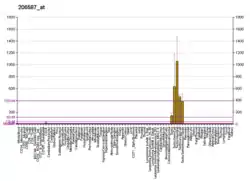CCT6B
T-complex protein 1 subunit zeta-2 is a protein that in humans is encoded by the CCT6B gene.[5][6][7]
This gene encodes a molecular chaperone that is a member of the TRiC complex. This complex consists of two identical stacked rings, each containing eight different proteins. Unfolded polypeptides enter the central cavity of the complex and are folded in an ATP-dependent manner. The complex folds various proteins, including actin and tubulin. Alternate transcriptional splice variants of this gene have been observed but have not been thoroughly characterized.[7]
References
- GRCh38: Ensembl release 89: ENSG00000132141 - Ensembl, May 2017
- GRCm38: Ensembl release 89: ENSMUSG00000020698 - Ensembl, May 2017
- "Human PubMed Reference:". National Center for Biotechnology Information, U.S. National Library of Medicine.
- "Mouse PubMed Reference:". National Center for Biotechnology Information, U.S. National Library of Medicine.
- Ozaki K, Kuroki T, Hayashi S, Nakamura Y (Jan 1997). "Isolation of three testis-specific genes (TSA303, TSA806, TSA903) by a differential mRNA display method". Genomics. 36 (2): 316–9. doi:10.1006/geno.1996.0467. PMID 8812458.
- Kubota H, Hynes GM, Kerr SM, Willison KR (Feb 1997). "Tissue-specific subunit of the mouse cytosolic chaperonin-containing TCP-1" (PDF). FEBS Lett. 402 (1): 53–6. doi:10.1016/S0014-5793(96)01501-3. PMID 9013858. S2CID 1972107.
- "Entrez Gene: CCT6B chaperonin containing TCP1, subunit 6B (zeta 2)".
External links
- Human CCT6B genome location and CCT6B gene details page in the UCSC Genome Browser.
Further reading
- Stirling PC, Cuéllar J, Alfaro GA, et al. (2006). "PhLP3 modulates CCT-mediated actin and tubulin folding via ternary complexes with substrates". J. Biol. Chem. 281 (11): 7012–21. doi:10.1074/jbc.M513235200. PMID 16415341.
- Gerhard DS, Wagner L, Feingold EA, et al. (2004). "The Status, Quality, and Expansion of the NIH Full-Length cDNA Project: The Mammalian Gene Collection (MGC)". Genome Res. 14 (10B): 2121–7. doi:10.1101/gr.2596504. PMC 528928. PMID 15489334.
- Suzuki Y, Yamashita R, Shirota M, et al. (2004). "Sequence Comparison of Human and Mouse Genes Reveals a Homologous Block Structure in the Promoter Regions". Genome Res. 14 (9): 1711–8. doi:10.1101/gr.2435604. PMC 515316. PMID 15342556.
- Strausberg RL, Feingold EA, Grouse LH, et al. (2003). "Generation and initial analysis of more than 15,000 full-length human and mouse cDNA sequences". Proc. Natl. Acad. Sci. U.S.A. 99 (26): 16899–903. doi:10.1073/pnas.242603899. PMC 139241. PMID 12477932.
- Suzuki Y, Yoshitomo-Nakagawa K, Maruyama K, et al. (1997). "Construction and characterization of a full length-enriched and a 5'-end-enriched cDNA library". Gene. 200 (1–2): 149–56. doi:10.1016/S0378-1119(97)00411-3. PMID 9373149.
- Maruyama K, Sugano S (1994). "Oligo-capping: a simple method to replace the cap structure of eukaryotic mRNAs with oligoribonucleotides". Gene. 138 (1–2): 171–4. doi:10.1016/0378-1119(94)90802-8. PMID 8125298.
This article is issued from Wikipedia. The text is licensed under Creative Commons - Attribution - Sharealike. Additional terms may apply for the media files.




